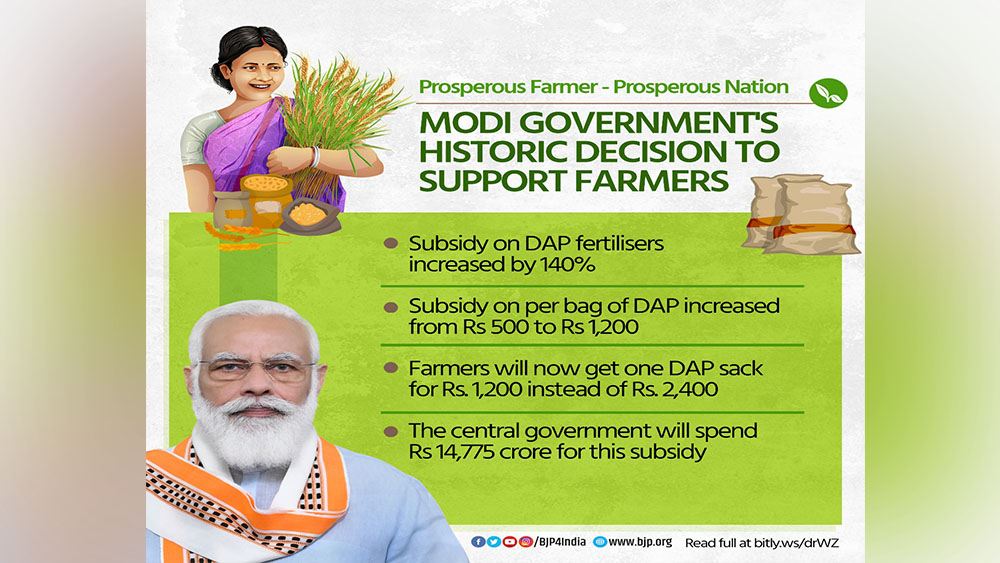
INCREASED SUBSIDY ON DAP
WHY IN NEWS?
Recently, the government has increased the subsidy to 140% on Di-Ammonium Phosphate (DAP) fertiliser in order to retain the selling price for farmers at the current level.
Recently, the international prices of phosphoric acid, ammonia etc. used in DAP have gone up by 60% to 70%.
IN DEPTH:
ABOUT DI-AMMONIUM PHOSPHATE (DAP):
DAP is the second most commonly used fertiliser in India after urea.
Farmers normally apply this fertiliser just before or at the beginning of sowing, as it is high in phosphorus (P) that stimulates root development.
DAP (46% P, 18% Nitrogen) is the preferred source of Phosphorus for farmers. This is similar to urea, which is their preferred nitrogenous fertiliser containing 46% N.
ABOUT SUBSIDY SCHEME FOR FERTILISERS:
Under the current scheme, the MRP of Urea is fixed but the subsidy can vary while MRP of DAP is decontrolled (i.e subsidy is fixed but the MRP can vary).
All Non-Urea based fertilisers are regulated under Nutrient Based Subsidy Scheme.
ABOUT NUTRIENT-BASED SUBSIDY (NBS) REGIME:
Under the NBS regime – fertilizers are provided to the farmers at the subsidized rates based on the nutrients (N, P, K & S) contained in these fertilizers.
Also, the fertilizers which are fortified with secondary and micronutrients such as molybdenum (Mo) and zinc are given additional subsidy.
The subsidy on Phosphatic and Potassic (P&K) fertilizers is announced by the Government on an annual basis for each nutrient on a per kg basis – which are determined taking into account the international and domestic prices of P&K fertilizers, exchange rate, inventory level in the country etc.
NBS policy intends to increase the consumption of P&K fertilizers so that optimum balance (N:P:K= 4:2:1) of NPK fertilization is achieved.
This would improve soil health and as a result the yield from the crops would increase, resulting in enhanced income to the farmers.
Also, as the government expects rational use of fertilizers, this would also ease off the burden of fertilizer subsidy.
It is being implemented from April 2010 by the Department of Fertilizers, Ministry of Chemicals & Fertilizers.
ISSUES RELATED TO NBS:
IMBALANCE IN PRICE OF FERTILISERS:
Urea is left-out in the scheme and hence it remains under price control as NBS has been implemented only in other fertilizers.
There is an imbalance as the price of fertilizers (other than urea) — which were decontrolled have gone up from 2.5 to four times during the 2010-2020 decade.
However, since 2010, the price of urea has increased only by 11%. This has led to farmers using more urea than before, which has further worsened fertilizer imbalance.
COSTS ON ECONOMY AND ENVIRONMENT:
Fertilizer subsidy is the second-biggest subsidy after food subsidy, the NBS policy is not only damaging the fiscal health of the economy but also proving detrimental to the soil health of the country.
Black Marketing: Subsidised urea is getting diverted to bulk buyers/traders or even nonagricultural users such as plywood and animal feed makers.
It is being smuggled to neighbouring countries like Bangladesh and Nepal.
IMPLICATIONS OF INCREASING THE SUBSIDY ON DAP:
As farmers will start sowing operations for Kharif Crops, it is highly important for them to get the fertilisers at subsidised rate so as to keep inflation at check.
Politically, too, to turn down the farmer protests, during the time of the Covid’s second wave, is the last thing the government would want.
